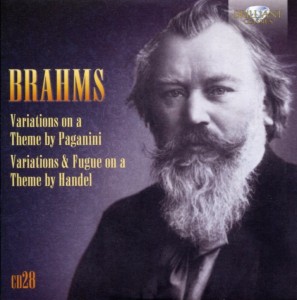Finally, Brahms really lets loose, creating variations on a theme by Paganini as well as variations and fugue on a theme by Handel that have life, pizazz, verve…balls.
One of the things that has exasperated me about Brahms is that he seems so reserved, so intellectual, so emotionally walled off that his music doesn’t freakin’ roar.
It doesn’t grab and shake, doesn’t command that I pay attention to it.
Beethoven’s music did that.
Oh, man. Seriously, Ludwig’s music kicked my ass so many times that I couldn’t sit down for a week. I found it to be raw, powerful…full of rage, melancholy, and laughter.
Brahms, on the other hand, writes music – to my ears, anyway – that is respectable, but painfully restrained. It just doesn’t move me. (Well, Haydn’s music didn’t move me at all. Brahms moves me a little bit. But, still, nowhere near on the scale of Beethoven or even Mozart.)
That’s why music like what I’m hearing on today’s CD causes me to sit up and take notice.
It’s different.
And different in a very good way.
Unleashed may be closer to the term I’m looking for.
Here’s what I heard today:
Variations on a Theme by Paganini in A minor
According to its entry on Wikipedia:
Variations on a Theme of Paganini, Op. 35, is a work for piano composed in 1863 by Johannes Brahms, based on the Caprice No. 24 in A minor by Niccolò Paganini.
Brahms intended the work to be more than simply a set of theme and variations; each variation also has the characteristic of a study. He published it as Studies for Pianoforte: Variations on a Theme of Paganini. It is uncharacteristically showy for Brahms, even Lisztean. Indeed, the work was composed for the piano virtuoso Carl Tausig.
It is well known for its emotional depth and technical challenges. Writer David Dubal describes it as “a legend in the piano literature,” and “fiendish,” “one of the most subtly difficult works in the literature.” Clara Schumann called it Hexenvariationen (Witch’s Variations) because of its difficulty.
See?
I told you this was different. It crackles with life. Because it’s difficult to play, it’s more entertaining to hear being played.
Brahms was 30 when he composed these brilliant variations.
By the way, pianist Wolfram plays these very, very well, with grand flourish and vigor.
From Studies Op. 35 Book II
Variation and Fugue on a Theme by Handel in B flat Op. 24
From its entry on Wiki:
The Variations and Fugue on a Theme by Handel, Op. 24, is a work for solo piano written by Johannes Brahms in 1861. It consists of a set of twenty-five variations and a concluding fugue, all based on a theme from George Frideric Handel’s Harpsichord Suite No. 1 in B-flat major, HWV 434.
The great music writer Donald Tovey has ranked it among “the half-dozen greatest sets of variations ever written”. Biographer Jan Swafford describes the Handel Variations as “perhaps the finest set of piano variations since Beethoven”, adding, “Besides a masterful unfolding of ideas concluding with an exuberant fugue with a finish designed to bring down the house, the work is quintessentially Brahms in other ways: the filler of traditional forms with fresh energy and imagination; the historical eclectic able to start off with a gallant little tune of Handel’s, Baroque ornaments and all, and integrate it seamlessly into his own voice, in a work of massive scope and dazzling variety.”
Brahms was 28 when he composed these brilliant piano pieces.
Here’s who played it:

